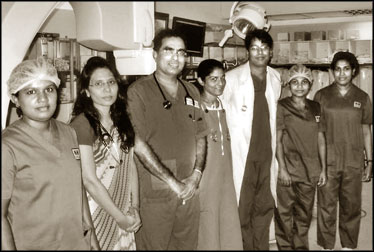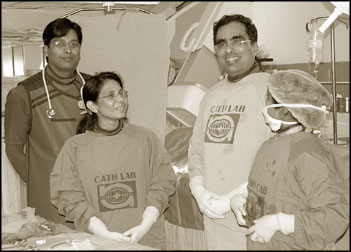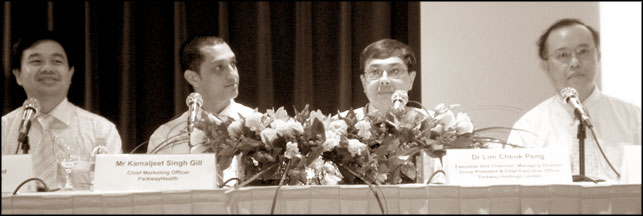Healthwise
"Landmark" medical interventional procedure:
Miracles are made in hospitals
Dhaneshi YATAWARA
 |
|
Nandani Rajapaksa, the
patient with the medical team. |
For Nandani, a mother of two little kids, hopes returned to her life
through greater suffering. She did not overcome breathlessness,
tiredness and all that may have looked like a lung disease for over one
and a half years until her fate made a miracle in her life.
"Doctors gave treatment for my tiredness. But it never got cured,"
Nandani said. "I don't have words to describe the suffering I underwent.
I couldn't speak even a few words at a stretch," she said now in a
flawless voice. " Now my one and half year old son is thrilled because I
can lift and carry him about," she beamed with joy - she just could not
cuddle or cradle her little son because of her impediment.
Nandani Rajapaksa (42) with her two children lives in Kegalle under
the loving care of her sister. Her unfortunate period, of time and all
of a sudden saw a ray of hope, thanks to her nearest and dearest who
were never ready to give up.
According to medical terminology, she was suffering from Pulmonary
Arteriovenous fistula in the right lung - A sort of a pathological
disorder in the communication system between the pulmonary vein and the
pulmonary artery bypassing the lung, where the oxygenated blood gets
flows back to the heart. In the fistula the 'clean' blood get mixed with
the 'unclean' blood diluting the oxygen percentage in the blood.
Thereby, her entire body was suffering from oxygen deficiency.
"About one and a half years ago my nail, both fingers and toes, were
turning blue and I also developed breathlessness and tiring very
quickly," Nandani said.
After working in Kuwait for seventeen long years until she got
married, she was leading a very normal life since her birth and this
sudden change was a shock to her entire family. Her husband Wipul
Samansiri, her brother Luxman were desperately trying to find a cure for
her while her entire family lovingly cared for her, who was now almost
bedridden.
"My children, Aruni Bhagya (6) and Ashen Dhanujaya (1 1/2 years),
were born under normal conditions. I was working in Kuwait for 17 years
and not even the climate change affected me," she added. As Nandani
said, she came to Sri Lanka with her two kids in 30 September 2007 as
the couple wanted to raise the children in Sri Lanka and to be educated
in Sinhala. Her husband is still working in Kuwait, for seven years, as
a driver in a private company.
When she consulted a doctor at the Chest Clinic of the Kegalle
Hospital the doctor has confirmed that her this has oilnment had nothing
to do with lungs. Only then she was put on the right track and after
several medical checks was referred to Dr. S. Mithrakumar the Chief
Interventional Cardiologist of the Cardiac Unit of the Nawaloka
Hospital, Colombo.
Looking for all possible options a cure for his sister, Nandani's
brother, Luxman Rajapaksa had strangled across a news article about Dr.
Mithrakumar, who was willing to help patients with risky heart
conditions.
The miracle
With her family she came to meet Dr. Mithrakumar a week ago. "He was
very friendly and kind to me. I really had a lot of confidence in him,"
Nandani added. Nandani had to first find the money for the procedure.
She, her brother and her husband were not ready to give up. For people
like Nandani, coming from an average Sri Lankan family, the cost was
pretty high. But, luck was with her. Her Family collected the money
within two months and came back to the specialist. Seeing her courage
and determination, the team of doctors were kind enough to waive off
their fees.
 |
|
Dr. Sharma, Dr. Lalini Kapuruge and
Dr.Mithrakumar after their ‘landmark’ medical interventional
procedure. |
"This was one of those rare case, and I weighed the case with my
team. To me their contribution meant a lot. Their ideas, decisions at
different crucial levels will be the main contributor to our
achievement," he added.
"At the very start, there was a slight hesitation but the patient's
was a personal challenge to our ego". bring hope and enjoyment for
another human being.
It is worthy to mention, Dr. Mithrakumar and his paramedical staff
had the support of Consultant Interventional Cardiologist Dr. (Mrs)
Lalani Kapuruge and the Consultant Cardiac Anaesthetist Dr. S. K.
Sharma.
In the natural blood circulation system of the human body, periphery
veins bring the deoxygenated blood (with very low oxygen percentage) to
the right side of the heart and through the Pulmonary artery the 'dirty'
blood is sent to the lungs to be oxygenated and after through the
pulmonary vein the 'clean' blood is sent back to the left side of the
heart and then from there it is pumped out to be circulated through the
entire body.
"In this case there was an abnormal connection between the artery and
the vein which had enlarged over time as the blood presses the walls,"
Dr.S.K. Sharma explained. Hence, proper oxygenation of the blood was not
taking place in her body. At the time of her admission to it was to the
hospital her oxygen saturation level was between 60 -65% even with an
external oxygen supply.
"When blood with low oxygen percentage circulates through the body we
can see blue colour in nails and lips. This is due to the blue colour of
the deoxygenated blood. Oxygenated blood is of pink colour," Dr. Sharma
said explaining the symptoms seen on Nandani.
Planning
The team led by Dr. Mithrakumar immediately took Nandani for an
examination and discovered the fistula - the exact cause for her
illness.
The next step was planning the treatment. "Since this was inside the
lung we could not go for a surgery because it might damage the lung
tissues," Dr. Kapuruge added.
"Anaesthetizing such patients is also risky as their oxygen level is
very low. And when she is unconscious she does not feel anything as to
what is happening to her which is another great risk," Dr. Sharma, the
Cardiac Anesthesist of the team, said.
"So we just had to sedate her and perform the procedure with a local
anaesthesia at the small incision in her right thigh," Dr. Mithrakumar
added.
A small catheter was inserted through her right thigh to the right
side of heart through the femoral vein and then to the pulmonary artery
and to the fistula.Dr. Mithrankumar identified that this fistula needed
to be blocked to avoid blood entering it and make the blood flow in the
correct path. In trying to find a blocking device they decided to try
Atrial Septal Occluder, the mesh like blocker that is used to cover
holes in the heart - A thought that would only tickle in the brain when
a doctor thinks going out of the frame.
Yet, to assure that their procedure is correct first they sent a
Atrial Septal defect measuring balloon through the catheter - a device
normally used to open narrowed arteries blocked with cholesterol, to
block the fistula and to see the improvement in the oxygen saturation of
the patient.
Immediately the oxygen saturation level started to gradually rise to
92% from 65%. Her body responded positively.
Based on improvement the team went ahead and decided to insert the
Atrial Septal Occluder device, the mesh, as the blocker.
The diameter of the fistula was 13 -14 mm and they chose the device
with 17mm width so it can stay attached to the walls of the fistula
tolerating the pulmonary artery pressure. The Atrial Septal Occluder
device was sent through the catheter in to the fistula.
"In a period of time this will get permanently blocked. Platelets and
blood cells will stick to the mesh, as there is still a flow of blood,
at a negligible level, to the fistula.
As the blood gets clotted it will form a firm block," Dr. Sharma
explained further.At the time of her discharge, few days ago, her blood
oxygen level rose to 92%.
"This, according to my knowledge, must be the first time such a case
was solved using an interventional procedure," Dr. Kapuruge added.
Recovery
Nandani lost 16 killogrammes of the her body weight during the one
and half years she suffered. "I want to get my strength back and look
after my family. For that I totally depend on the advice of Dr.
Mithrankumar. They saved my life," Nandani was at a loss for words to
express her gratitude.
Last but not the least, the team of experts did not forget to express
their thanks to their institute - the Nawaloka Hospital, especially the
recent expanded the Emergency Care Unit.
"Without a proper equipment and technology we could not have saved
the life of this innocent person and bring back the joy to her and her
family," they echoed.
Health News:
Innovative patient-centric initiative from Singapore's ParkwayHealth
Samangie WETTIMUNY
Singapore's ParkwayHealth which is one of Asia's leading private
healthcare providers recently launched the second phase of its fixed
price package in response to the current economic condition, with an
intention of helping patients with better managed costs. The first phase
of introduction of fixed price package took place in late March, 2009.
The packages cover key areas, cardiology, ENT surgery, Gastroenterology,
general surgery, neurosurgery, obstetrics and gynaecology,
ophthalmology, orthopaedic surgery and urology.
 |
|
(From left): Dr. Lewis Liew,
Consultant Urologist, Kamalijeet Singh Gill, Chief Marketing
Officer, Global Corporate Marketing of ParkwayHealth, Dr.
Lim. Cheok Peng, Executive Vice Chairman, Managing Director,
Group President and Chief Executive Officer of Parkway
Holdings Ltd, and Prof. Lim Yean Teng, Consultant
Cardiologist at the launch of ParkwayHealth’s innovative
patient-centric initiative held in Gleneagles Hospital
auditorium in Singapore recently. |
In total there are 34 `most inclusive, comprehensive and innovative'
packages, with a validity period of one year. ParkwayHealth totally
believes that the packages are innovative mainly because they are the
No. 1 private healthcare provider in Singapore that combine patient
safety and quality of service with competitive and all-inclusive
pricing.
"We believe that fixed price packages would bring cheer to those who
are in need of medical attention, said Dr. Lim. Cheok Peng, Executive
Vice Chairman, Managing Director, Group President and Chief Executive
Officer of ParkwayHoldings Ltd speaking at the launch.
He further added that the aim of ParkwayHealth is to make essential
treatment affordable and accessible during this crisis period. All 34
packages are meant to cater to meet the needs of local and foreign
patients.
"Parkway never compromises when it comes to health. Healthcare needs
should be addressed during bad times as well. We believe that with these
all-in-one packages, both local and foreign patients will be encouraged
not to delay or put off much needed surgery."
According to Kamalijeet Singh Gill, Chief Marketing Officer, Global
Corporate Marketing of ParkwayHealth, the fixed pricing structure allows
ParkwayHealth to deliver their fixed-price promise to help patients who
are in need of medical care to bring down their healthcare costs.
Gill further emphasized that the new price packages are truly a
patient-centric initiative that aims at easing costs for patients. More
information regarding fixed price packages could be obtained from
www.parkwayhealth.com, www.parkwayholdings.com or www.ppac.sg.
ParkwayHealth which is based in Singapore operates 15 hospitals in
Asia and 43 patient assistance centres around the globe and the Colombo
office is located at 389 High Level Road, Nugegoda. |

